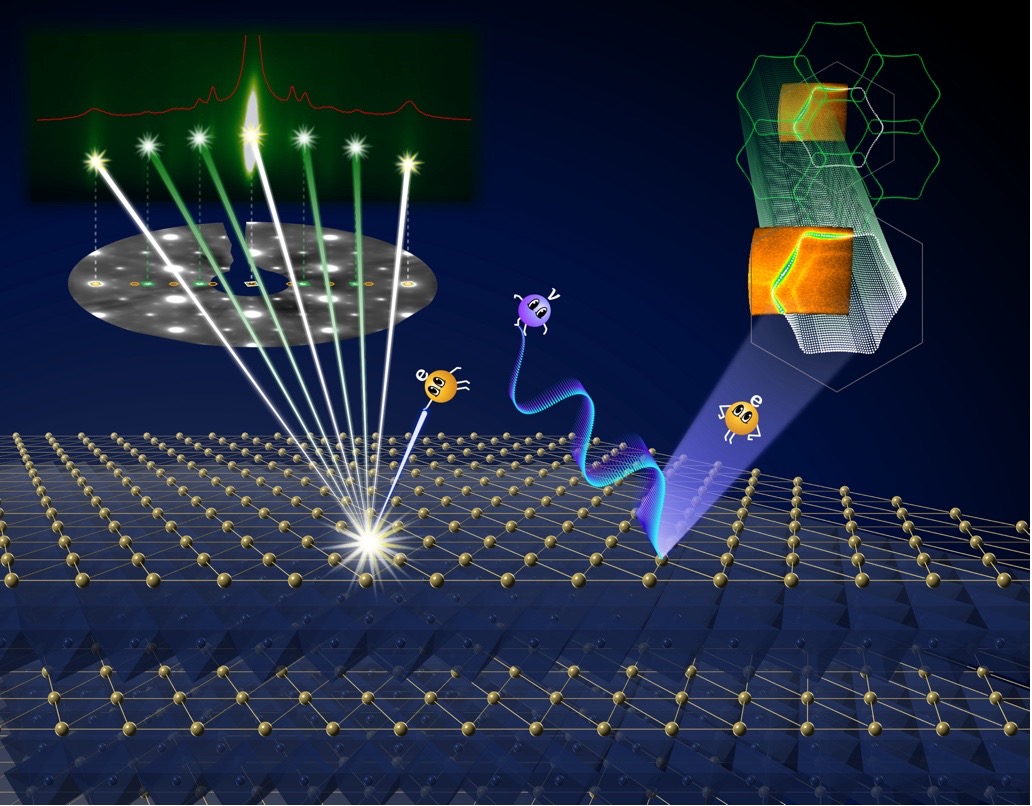PARADIM Highlight #95—In-House Research and REU Program (2024)
Kyle M. Shen, Darrell G. Schlom, and Craig J. Fennie (PARADIM and Cornell University)
REU students have a multitude of backgrounds but share a common thirst: to do cutting-edge research. As part of its 10-week immersion in hands-on research, PARADIM encourages its REU students to dive in and learn new techniques at the same time they experience the power of team-based research. Such a team has been studying low-dimensional metallic delafossites, with the general formula ABO2, with the goal of producing electronic and magnetic characteristics that are not accessible in single crystals of these materials. These layered structures consist of alternating monolayers of Pt or Pd alternating with monolayers of CoO2 or CrO2 and have conductivities that are the highest of any oxide—surpassing those of Pt and Pd metals even.

Figure 1: The surface of PtCoO2 studied by (left) two types of electron diffraction (LEED and RHEED) showing a change in atomic structure on the surface of the film compared to the underlying atomic layers.(center) Angle-resolved photoemission spectroscopy is used to reveal how the electrons are moving in the PtCoO2 film, including the effect of the altered surface structure.

Figure 2: Photographs of the three PARADIM REUs who are among the co-authors. Right to Left: QIng Xu, Yufan Feng, and Sonia Hasko.
Together with its REU students, the PARADIM In-House Team successfully synthesized high-quality PtCoO2, PdCoO2, and PdCrO2 films by MBE, followed by a comprehensive investigation of their surface reconstructions using a combination of ARPES, LEED, and RHEED, plus assessment of the structural quality (by AFM, XRD, and TEM) and their electronic conductivity as a function of thickness. New surface reconstructions were seen. First-principles calculations from PARADIM’s theory user facility shed light on the relative instability of surfaces terminated with A (A = Pt, Pd) atoms compared to those terminated with BO2 (B = Co, Cr), as evidenced by their higher formation energies.
This work sets the stage for further exploration of highly two-dimensional studies in this intriguing class of quantum materials.
The growing interest in the growth and study of thin films of low-dimensional metallic delafossites, with the general formula ABO2, is driven by their potential to exhibit electronic and magnetic characteristics that are not accessible in bulk systems. The layered structure of these compounds introduces unique surface states as well as electronic and structural reconstructions, making the investigation of their surface behavior pivotal to understanding their intrinsic electronic structure. In this work, we study the surface phenomena of epitaxially grown PtCoO2, PdCoO2, and PdCrO2 films, utilizing a combination of molecular-beam epitaxy and angle-resolved photoemission spectroscopy. Through precise control of surface termination and treatment, we discover a pronounced surface reconstruction in PtCoO2 films and PdCoO2 films, alongside a 2 × 2 surface reconstruction observed in PdCrO2 films. These reconstructions have not been reported in prior studies of delafossites. Furthermore, our computational investigations demonstrate the BO2 surface’s relative stability compared to the A-terminated surface and the significant reduction in surface energy facilitated by the reconstruction of the A-terminated surface. These experimental and theoretical insights illuminate the complex surface dynamics in metallic delafossites, paving the way for future explorations of their distinctive properties in low-dimensional studies.
This work made use of PARADIM’s MBE+ARPES capability that also has in situ LEED and RHEED. All were used in this study. Successful synthesis of these conducting phases requires high oxygen activity to oxidize the Pt and Pd constituents to Pt+ and Pd+. This is where PARADIM’s unique 62-element MBE providing distilled ozone for hard-to-oxidize constituents is pivotal. The result was epitaxial PtCoO2, PdCoO2, and PdCrO2 films of the highest structural and electrical quality produced to date in the form of thin films. Calculations of the electronic properties were supported by the PARADIM Theory User Facility.
This study conducted by the PARADIM In-House Team is part of their research effort in weaving quantum fabrics with new properties and functionalities that cannot be commonly accessed in bulk materials. Participants of PARADIM’s annual REU program perform authentic research alongside members of the Platform and become co-authors on resulting manuscripts
Q. Song, Z. He, B.D. Faeth, C.T. Parzyck, A. Scheid, C.J. Mowers, Y. Feng, Q. Xu, S. Hasko, J. Park, M.R. Barone, Y.E. Suyolcu, P.A. van Aken, B. Pamuk, C.J. Fennie, P.D.C. King, K.M. Shen, and D.G. Schlom, "Surface Reconstructions and Electronic Structure of Metallic Delafossite Thin Films," APL Mater. 12, 081117 (2024). DOI: https://doi.org/10.1063/5.0217540
This paper was primarily supported by the U.S. Department of Energy, Office of Basic Sciences, Division of Materials Science and Engineering under Award No. DE-SC0002334. This research was funded in part by the Gordon and Betty Moore Foundation’s EPiQS Initiative (Grant Nos. GBMF3850 and GBMF9073 to Cornell University). This paper made use of the Cornell Center for Materials Research shared facilities, which are supported through the NSF Materials Research Science and Engineering Centers Program (Grant No. DMR-1719875). B.D.F., M.R.B., and B.P. acknowledged support from the National Science Foundation Platform for the Accelerated Realization, Analysis, and Discovery of Interface Materials (PARADIM) under Cooperative Agreement No. DMR-2039380. This paper also made use of the Cornell Energy Systems Institute Shared Facilities partly sponsored by the NSF (Grant No. MRI DMR-1338010) and the Kavli Institute at Cornell. Substrate preparation was performed, in part, at the Cornell NanoScale Facility, a member of the National Nanotechnology Coordinated Infrastructure, which is supported by the NSF (Grant No. NNCI-2025233). P.K. acknowledged support from the European Research Council (through the QUESTDO Project, 714193) and The Leverhulme Trust (Grant No. RPG-2023-256).







